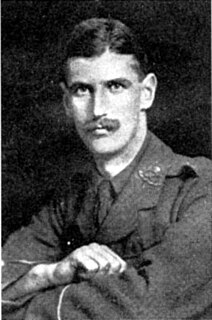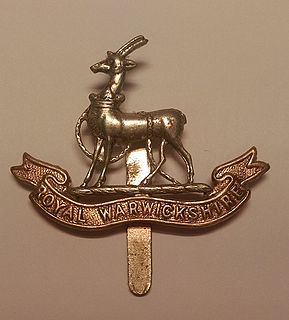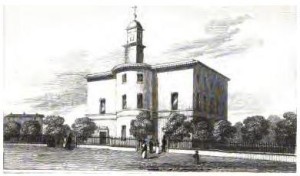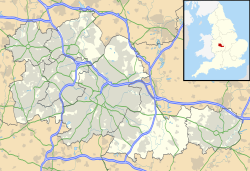
The 61st Division was an infantry division of the British Army raised in 1915 during the Great War as a second-line reserve for the first-line battalions of the 48th Division. However, the division was sent to the Western Front in May 1916 and served there for the duration of the First World War.
Duddeston is an inner-city area of the Nechells ward of central Birmingham, England. It was part of the Birmingham Duddeston constituency until that ceased to exist in 1950.

Catterick Garrison is a major garrison and military town 3 miles (5 km) south of Richmond, North Yorkshire, England. It is the largest British Army garrison in the world, with a population of around 13,000 in 2017 and covering over 2,400 acres. Under plans announced by the Ministry of Defence (MoD) in November 2005, its population is expected to grow to over 25,000, making it the largest population centre in the local area.

The 46th Division was an infantry division of the British Army, part of the Territorial Force, that saw service in the First World War. At the outbreak of the war, the 46th Division was commanded by Major-General Hon. E.J. Montagu-Stuart-Wortley. Originally called the North Midland Division, it was redesignated as the 46th Division in May 1915.

John Leslie Green VC was an English recipient of the Victoria Cross, the highest and most prestigious award for gallantry in the face of the enemy that can be awarded to British and Commonwealth forces. An officer in the Royal Army Medical Corps, he served on attachment to The Sherwood Foresters during the First World War. He was posthumously awarded the VC for his actions on 1 July 1916, during the Battle of the Somme.

The Cross-City Line is a commuter rail line in the West Midlands region of England. It runs for 32 mi (51 km) from Redditch and Bromsgrove in Worcestershire, its two southern termini, to Lichfield, Staffordshire, its northern terminus, via Birmingham New Street, connecting the suburbs of Birmingham in between. Services are operated by West Midlands Trains.

The Royal Warwickshire Regiment, previously titled the 6th Regiment of Foot, was a line infantry regiment of the British Army in continuous existence for 283 years. The regiment saw service in many conflicts and wars, including the Second Boer War and both the First and Second World Wars. On 1 May 1963, the regiment was re-titled, for the final time, as the Royal Warwickshire Fusiliers and became part of the Fusilier Brigade.

Duddeston railway station is situated in the Duddeston area of Birmingham, England on the Redditch-Birmingham New Street-Lichfield Cross-City Line and the Walsall line. Services on both lines are usually operated by Class 323 electric multiple units, although Class 350 electric multiple units are also commonly used on services to and from Walsall as well as occasional stopping service by Class 170 diesel multiple units.

Nechells is a district ward in central Birmingham, England, whose population in 2011 was 33,957. It is also a ward within the formal district of Ladywood. Nechells local government ward includes areas, for example parts of Birmingham city centre, which are not part of the historic district of Nechells as such, now often referred to in policy documents as "North Nechells, Bloomsbury and Duddeston".
Budbrooke is a small village and civil parish in the Warwick district of Warwickshire, England, about 2½ miles west of Warwick town centre. According to the 2001 census the parish had a population of 2,319, reducing to 1,863 at the 2011 Census. The majority of the population of Budbrooke live in Hampton Magna, a housing estate built in the late 1960s, with other smaller settlements in Budbrooke Village and Hampton on the Hill.

Julius Alfred Chatwin FRIBA, ARBS, FSAScot was a British architect. He was involved with the building and modification of many churches in Birmingham, and practised both Neo-Gothic and Neo-Classical styles. His designs always included all of the carvings and internal fittings.

The 6th Infantry Brigade was a regular infantry brigade of the British Army that was in existence during the Second Boer War, the First World War and the Second World War and later formed part of British Army of the Rhine.
This article is intended to show a timeline of events in the History of Birmingham, England, with a particular focus on the events, people or places that are covered in Wikipedia articles.

Ashted is an area of Birmingham in the United Kingdom, within the ward of Nechells. The area is located approximately 0.75 miles (1.21 km) north-east of Birmingham City Centre near to the city's Eastside district, and forms the western extremity of Duddeston. It is within the boundaries of Nechells Green, and provides mainly estate and high-rise residences.
In September 1939, the British Army was in process of expanding their anti-aircraft and mobile assets. Among these new changes was the formation of Anti-Aircraft Command which was formed on 1 April 1939, and the 1st Armoured Division formed in 1937. The list below will include the British Army units, colonial units, and those units which were in the process of formation.
The 2nd South Midland Mounted Brigade was a yeomanry brigade of the British Army, formed as part of the Territorial Force in 1908.

The 59th Division was an infantry division of the British Army during World War I. It was formed in late 1914/early 1915 as a 2nd Line Territorial Force formation raised as a duplicate of the 46th Division. After training in the United Kingdom and saw service in the Easter Rising in April 1916, the division joined the British Expeditionary Force (BEF) on the Western Front in early 1917. It saw action at Ypres and Cambrai, and was almost destroyed during the German Army's Spring Offensive in March 1918. The reconstituted division took part in the final advances of the war.
The 224th Brigade was a Home Defence formation of the British Army in the First and the Second World Wars. It existed under several variations of the 224th Brigade title.
72nd Division was a short-lived infantry division of the British Army during World War I. It served in the Home Defence forces and never went overseas.
The following is a hierarchical outline for the structure of the British Army in 1989. The most authoritative source for this type of information available is Ministry of Defence, Master Order of Battle, and United Kingdom Land Forces, HQ UKLF, UKLF ORBAT Review Action Plan, HQ UKLF, 1990.












